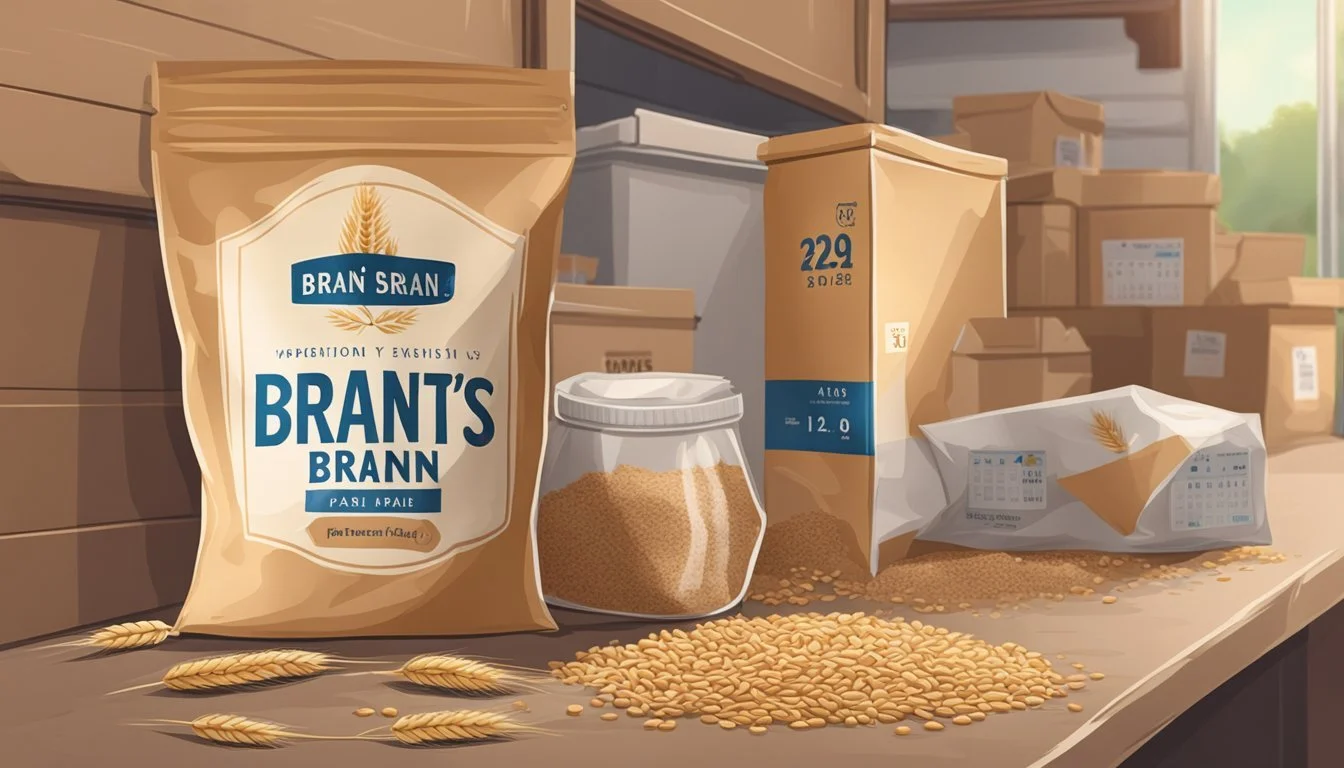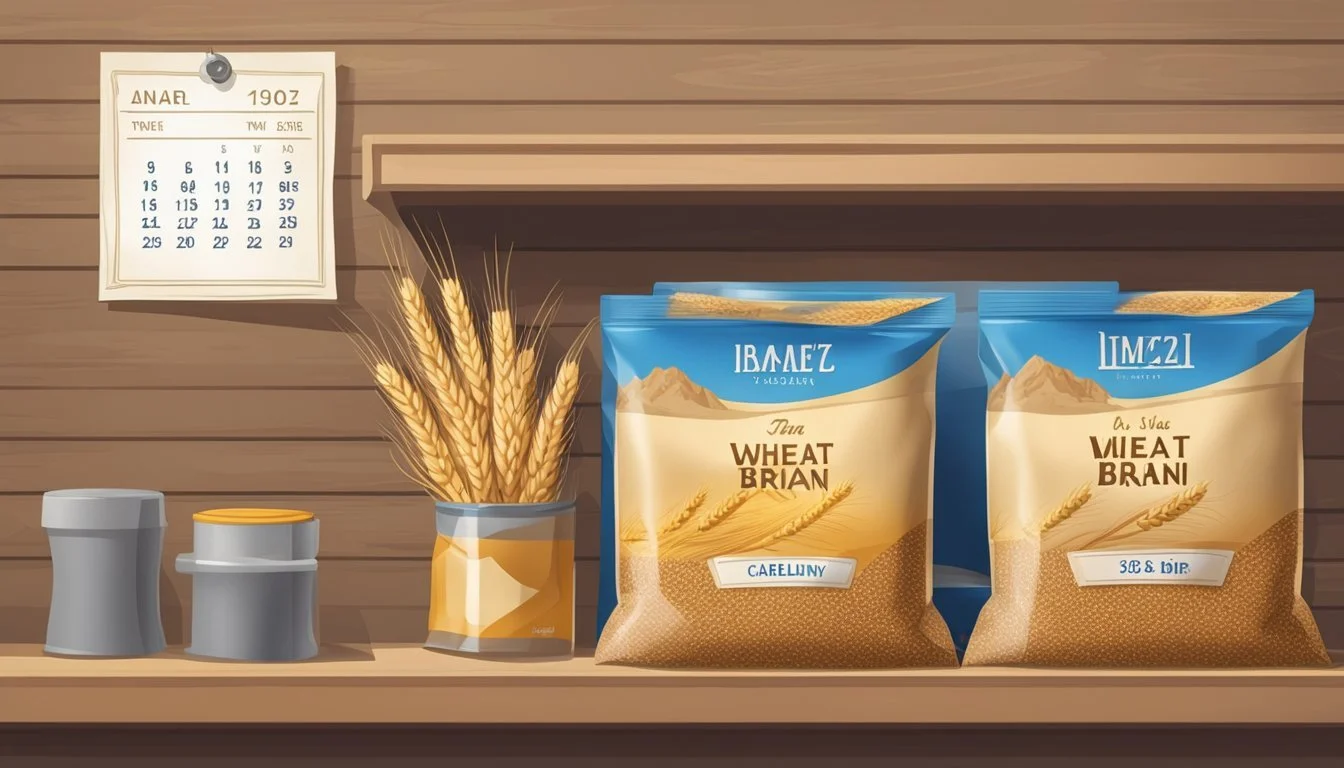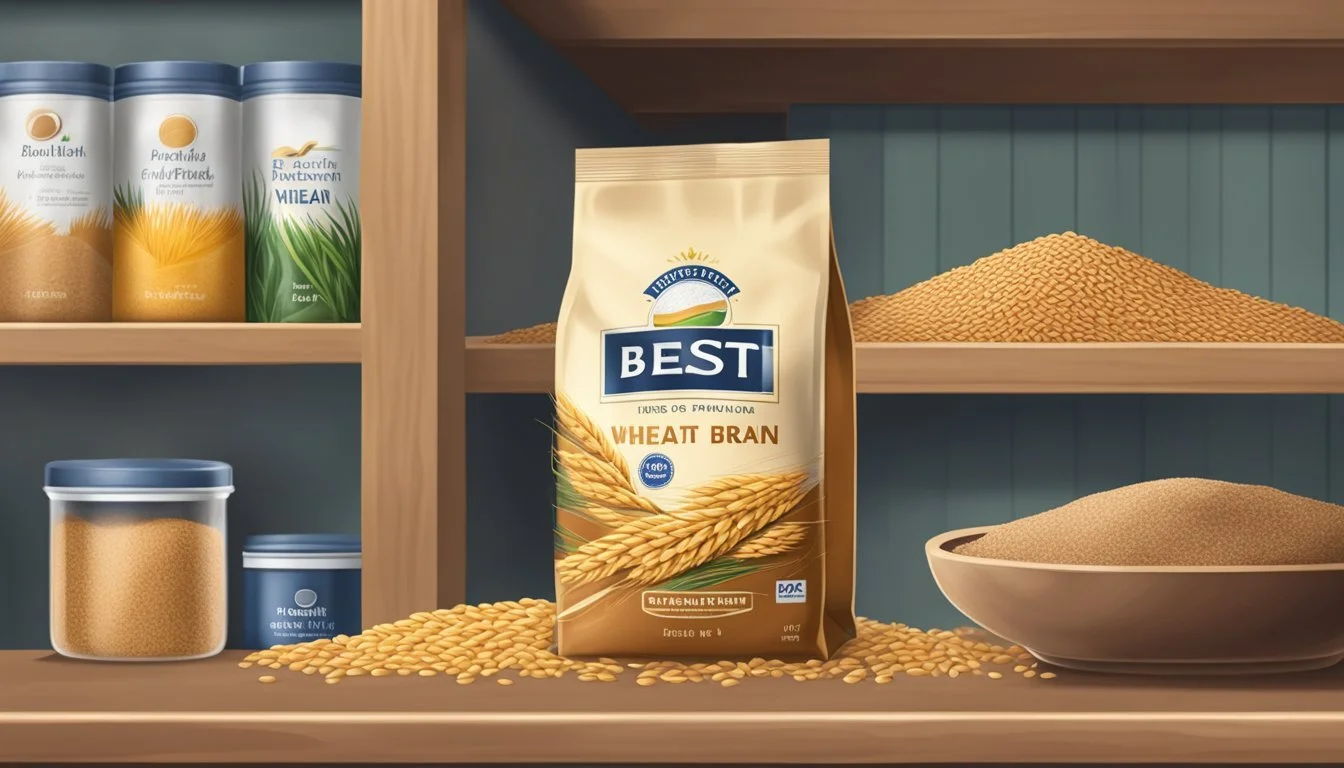How Long Does Wheat Bran Last?
Shelf Life and Storage Tips
Wheat bran (how long does wheat bran last?), the outer layer of the wheat kernel, is a popular dietary supplement known for its high fiber content. It is often incorporated into recipes in small amounts, and even though it's used sparingly, understanding its shelf life is important to maintain its freshness and nutritional value. Wheat bran is generally available prepackaged or from a bulk bin aisle and when stored correctly, can remain in good condition for use.
Optimal storage conditions for wheat bran involve keeping it in a cool, dry, and dark place to prolong its shelf life. Under these conditions, wheat bran can maintain its quality for a considerable amount of time. The freshness of wheat bran is crucial for taste and nutritional reasons, as it can develop an off flavor when it starts to go bad. Consumers should be aware of the shelf life to prevent any spoilage and waste of the product.
Understanding Wheat Bran
Wheat bran is the hard outer layer of the wheat kernel, often considered a byproduct of milling. It is a valuable source of nutrition and is incorporated into various dietary habits due to its high content of dietary fiber, protein, and essential minerals.
Composition of Wheat Bran
Wheat bran is comprised of multiple layers including the aleurone, pericarp, and the testa. They collectively form the most fibrous part of the grain and are rich in bioactive compounds. Wheat bran's composition is distinct from the endosperm and germ, which make up the rest of the wheat kernel.
Fibrous Components: Predominantly composed of dietary fiber, both insoluble and soluble.
Starch: Minimal starch present as compared to the endosperm.
Aleurone layer: Contains significant amounts of protein and phytochemicals.
Nutritional Profile
Wheat bran's nutritional content is impressive, making it a beneficial addition to a balanced diet.
Dietary Fiber: High in both soluble and insoluble fiber, beneficial for digestive health.
Protein: Contains a moderate amount of protein.
Vitamins and Minerals: A good source of B-vitamins, iron, and calcium.
Carbohydrates: Lower in carbohydrates than whole wheat due to the absence of the starchy endosperm.
The high dietary fiber content in wheat bran not only aids digestion but also contributes to a feeling of fullness, which can assist with weight management. Additionally, the mineral content, inclusive of iron and calcium, supports numerous bodily functions including metabolism and bone health.
Storage Fundamentals
To maximize the shelf life of wheat bran, understanding the ideal conditions and proper containers for storage is crucial.
Ideal Storage Conditions
Wheat bran's longevity is significantly influenced by its storage environment. It should be kept in a cool and dry place, away from direct sunlight and strong odors, where temperatures remain fairly stable. Ideally, the temperature should be between 40-60°F (4-15°C). Variances beyond this range can accelerate spoilage and lead to the degradation of quality.
Types of Storage Containers
Selecting the right storage containers is equally important to maintain the freshness of wheat bran.
Airtight Containers: Containers with a tight seal are necessary to prevent moisture and pests from compromising the wheat bran.
Material Choices: Glass or plastic are both suitable options for storage. Glass is inert and does not interact with the bran, while plastic is lightweight and shatter resistant.
Sizing: Using containers that appropriately fit the quantity of wheat bran can minimize air exposure.
Re-sealable Bags: If an airtight container is not available, one can use re-sealable plastic bags, ensuring they are sealed properly after every use.
Using mason jars or commercial airtight containers designed for food storage can further extend the shelf life. When using plastic, one should consider opting for BPA-free containers to minimize chemical interaction with the food.
By adhering to these specific storage fundamentals, one can ensure that their wheat bran remains fresh for as long as possible.
Shelf Life Determinants
When assessing the shelf life of wheat bran, one must consider the direct impact of storage conditions, particularly temperature and exposure to moisture and oxygen.
Influence of Temperature
Temperature plays a critical role in preserving the freshness of wheat bran. Storage in a cool environment is favorable as it helps to slow down any biochemical processes that can lead to spoilage. Ideally, wheat bran should be stored at room temperature if it's going to be used within a month. However, for longer storage, placing it in a refrigerator or freezer can significantly extend its shelf life.
Effects of Moisture and Oxygen
Wheat bran’s shelf life is also highly susceptible to the effects of moisture and oxygen. It should be kept in an airtight container to minimize the exposure to these elements. This helps prevent the growth of mold and rancidity, which moisture and oxygen can provoke. Additionally, storing wheat bran in a dark place prevents the degradation of nutrients that exposure to light can cause.
Signs of Deterioration
When it comes to wheat bran, detecting spoilage largely depends on sensory analysis. The reader should be aware that both visual cues and aroma play a crucial role in determining whether wheat bran has deteriorated.
Visual and Textural Changes
If wheat bran exhibits significant changes in its appearance or texture, it may indicate spoilage. The reader should look for a discoloration, such as a darker hue or spots that are not part of the natural color variation. Wheat bran has a naturally flaky texture, but if it clumps together or appears matted, moisture may have compromised its quality, leading to potential spoilage.
Odor and Flavor Alteration
Wheat bran should have a subtle, slightly nutty aroma and flavor when fresh. If the bran gives off a sharp, sour, or musty smell, this could be a sign that it has gone stale. Should it taste unusually bitter or off in flavor, this indicates that the natural oils found in wheat bran have started to deteriorate, which affects the overall quality.
Preventing Spoilage
Proper storage techniques can significantly extend the shelf life of wheat bran, preventing spoilage. Ensuring an airtight environment and choosing between refrigeration and freezing are crucial steps.
Proper Sealing Techniques
Sealing wheat bran in an airtight container is essential to protect it from moisture and pests, which can lead to spoilage. Suitable containers include:
Glass jars with tight-fitting lids.
Food-grade plastic containers with secure seals.
Sealable plastic bags, such as freezer bags, for flexibility and space-saving.
When storing, one must ensure there are no gaps or leaks in the seals. Any exposure to air can accelerate the degradation process.
Refrigeration vs. Freezing
Both refrigeration and freezing can keep wheat bran fresh, but they serve different needs:
Refrigeration: Ideal for short-term storage and regular use. Wheat bran can stay fresh in the fridge for up to one year if sealed correctly.
Freezing: Best for long-term storage. Freezing can extend the wheat bran's shelf life beyond a year. The freezer temperature must be stable to avoid moisture buildup from temperature fluctuations.
It's recommended that users store wheat bran in the coldest part of the fridge or freezer, away from the door, to maintain a consistent temperature.
Practical Tips for Wheat Bran Longevity
To maintain wheat bran's freshness and ensure its longevity, buyers should focus on proper purchase practices and storage methods. By following these guidelines, individuals can enjoy high-quality wheat bran for their baking and culinary needs.
Buying and Initial Storage
When purchasing wheat bran, one should opt for amounts that align with a 30-day usage cycle, minimizing the risk of spoilage. It is ideal to select packaging that is intact and properly sealed, which protects the wheat bran from exposure to air and humidity, factors that can degrade its quality. Retailers often offer wheat bran in both prepackaged and bulk bin options.
Purchase: Buy in quantities for a month's consumption.
Packaging: Choose sealed and undamaged packaging.
Upon bringing wheat bran home, it is recommended to store it in a cool, dry, and dark place, such as a pantry. For those using wheat bran infrequently, it can be stored in the freezer, which significantly extends its shelf life.
Pantry: Ideal for short-term storage; up to two years.
Freezer: Suitable for long-term storage; extends freshness.
Handling and Usage
Proper handling of wheat bran can reduce waste and preserve its quality. It is advised to use clean utensils when measuring out wheat bran to prevent cross-contamination. Furthermore, resealable containers are recommended for storing any remaining wheat bran after initial use to maintain freshness.
Handling: Use clean tools to avoid contamination.
Usage: Transfer to airtight containers after opening.
Moreover, if wheat bran is incorporated into a baking program or routine, users can gauge their required quantities more accurately, avoiding excess purchase and waste. This practice ensures that wheat bran is used within its optimal freshness period and maintains the desired quality in baking.
Cross-Contamination and Pest Prevention
When storing wheat bran, it's crucial to prevent cross-contamination and pest infestation to maintain its quality and extend its shelf life. Rigorous measures should be taken to avert contact with bugs, molds, and bacteria that can spoil the cereal.
Keeping Wheat Bran Bug-Free
Storage Containers: To keep wheat bran free of bugs, one should store it in airtight containers such as glass jars or food-grade plastic containers with tight-fitting lids. Sealable plastic bags, notably freezer bags, are also adequate if used properly.
Location: Placing wheat bran in the refrigerator or freezer is highly effective in deterring infestation by grain bugs, which cannot thrive in these cold temperatures.
Inspection: Regular inspection of stored cereals is essential for early detection of bugs. If pests are found, immediate disposal of the infected portion is advised to prevent the spread to other stored food items.
Mitigating Bacterial Growth
Dry Environment: Storing wheat bran in a dry environment mitigates bacterial growth. Moisture is the primary enabler of bacterial proliferation, which can lead to mold formation.
Monitoring Moisture Levels: It is important to monitor and control the moisture content of the storage area. Use of desiccants or maintaining low humidity levels in storage rooms can impede bacterial and mold growth.
Clean Storage Practices: Ensuring that the storage containers and areas are clean and free from remnants of previous storage materials will reduce the likelihood of bacterial contamination.
Through adherence to these specific practices, they can ensure the preservation of wheat bran's freshness, deterring the onset of spoilage caused by bugs, molds, and bacteria.
Comparative Shelf Lives
Grains have varying shelf lives depending on their processing and storage methods. Two crucial factors that affect the longevity of grains include whether they are whole or processed and their inherent oil content.
Wheat Bran vs. Other Grains
Wheat bran, the outer layer of the wheat kernel, generally has a shorter shelf life compared to more refined grain products. Wheat bran can stay fresh for several months, but due to its high oil content, it is prone to rancidity. On the other hand, grains like white rice and white flour, which have been stripped of their bran and germ, can last for years if stored properly. Brown rice, similar to wheat bran, has a higher oil content and thus a shorter shelf life of about 6 months to 1 year. In the case of whole grains, such as wheat berries, quinoa, and hard red wheat, they can last many years when kept in optimal conditions.
Processed vs. Whole Grain Products
The shelf life of grain products also depends heavily on their level of processing. Processed grains such as white rice and white flour can last significantly longer than their whole grain counterparts due to the removal of oil-rich components.
Grain Product Shelf Life (approx.) White rice Up to 5 years Brown rice 6 months to 1 year Wheat bran Several months Whole wheat flour (how long does whole wheat flour last?) 1 to 3 months White flour Up to 1 year Rolled oats (how long do rolled oats last?) 1 to 2 years
In contrast, whole grain products like whole wheat flour and rolled oats have a shelf life that ranges from several months to a couple of years when stored in an airtight container and placed in a cool, dry area. Hard wheat and red wheat, often used for milling into whole grain flour, have a shelf life that extends to a few months when the grain is left intact.
Health Considerations
When considering the shelf life of wheat bran, it's vital to also understand the health implications of incorporating it into one’s diet consistently. This section elaborates on the nutritional benefits and potential digestive issues that adults may encounter.
Benefits of Regular Consumption
Wheat bran is an excellent source of dietary fiber, which is crucial in promoting regular bowel movements and preventing constipation. Incorporating wheat bran into the diet offers multiple nutrients that contribute to overall health:
Dietary Fiber: Essential for digestive health, fiber aids in maintaining bowel regularity.
Protein: An important building block for muscles and enzymes.
Vitamins and Minerals: Wheat bran contains vitamins, particularly B-vitamins which are vital for metabolic processes, and minerals such as iron and magnesium.
The regular consumption of wheat bran can support nutrition and may help in the management of weight by providing a sense of fullness. A diet rich in fiber from wheat bran may also play a role in the prevention of certain chronic diseases.
Potential Digestive Issues
While the fiber in wheat bran is beneficial, it can cause digestive discomfort in some individuals, especially if they are not accustomed to a high-fiber diet or if they consume it in large quantities. One may experience:
Gas and Bloating: Sudden increased fiber intake can lead to discomfort.
Irritable Bowel Syndrome (IBS): People with IBS might find wheat bran exacerbates symptoms due to its high fiber content.
It is generally recommended to increase fiber intake gradually to allow the digestive system to adjust. Drinking plenty of water can also help mitigate digestive issues.
Additional Considerations and References
In dealing with the shelf-life of wheat bran, understanding its uses in cooking and the effectiveness of various preservation methods is crucial for maintaining its nutritional value and quality.
Substitution and Cooking
When incorporating wheat bran into their diet, individuals may consider substitution options in cooking. For instance, wheat bran can be added to baked goods such as bread or muffins to increase dietary fiber content. It is important to note that the substitution proportions can affect the moisture and texture of the final product given that wheat bran is ground and absorbs liquid.
Extending Shelf-Life with Preservation Methods
To extend the shelf-life of wheat bran, the right preservation methods need to be utilized. Freezing wheat bran can significantly reduce the rate of chemical degradation and preserve its quality. For optimal longevity, wheat bran should be stored in an airtight container and can be kept in the freezer where it retains quality for several months. Heating methods, such as toasting, which might be used in cooking, should also be considered as they can potentially impact the longevity and caloric value of wheat bran due to alteration of the wheat kernel components like the wheat germ.
Conclusion
When it comes to storing wheat bran, individuals should prioritize maintaining its freshness to derive the best nutritional value. Typically, wheat bran is consumable well beyond the purchase date if proper storage methods are adhered to. Optimal conditions for wheat bran include a cool, dry, and dark place—a pantry or a cupboard away from direct sunlight and moisture is ideal.
If one uses wheat bran infrequently, they may consider storing it in the freezer to extend its shelf life. As a general guideline, wheat bran stored at room temperature can reasonably last several months, whereas in the freezer, it can last up to a year or beyond without significant degradation in quality.
Users should also be mindful of signs of spoilage, which include off odors, changes in color, or the presence of mold. These are indicators that the bran has surpassed its usability and should be discarded.
In summary, with proper storage, wheat bran can remain a viable and nutritious component of one's diet for an extended period, making it a practical grain to keep on hand. Users are advised to monitor their wheat bran regularly to ensure it remains in the best condition for use.













